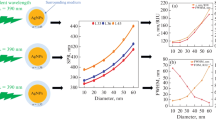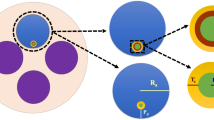Abstract
The sensitivities of five different core–shell nanostructures were investigated towards changes in the refractive index of the surrounding medium. The shift of the localized surface plasmon resonance (LSPR) maximum served as a measure of the (respective) sensitivity. Thus, gold–silver core–shell nanoparticles (NPs) were prepared with different shell thicknesses in a two-step chemical process without the use of any (possibly disturbing) surfactants. The measurements were supported by ultramicroscopic images in order to size the resulting core–shell structures. When compared to sensitivities of nanostructures reported in the literature with those of the (roughly spherical) gold–silver core–shell NPs, the latter showed comparable (or even higher) sensitivities than gold nanorods. The experimental finding is supported by theoretical calculation of optical properties of such core–shell NP. Extinction spectra of ideal spherical and deformed core–shell NPs with various core/shell sizes were calculated, and the presence of an optimal silver shell thickness with increased sensitivity was confirmed. This effect is explained by the existence of two overlapping plasmon bands in the NP, which change their relative intensity upon change of refractive index. Results of this research show a possibility of improving LSPR sensor by adding an extra metallic layer of certain thickness.

Figure: Left TEM image of gold-silver core-shell nanoparticle, Right Two images of E-field distribution in the core-shell nanoparticle at different excitation wavelengths.







Similar content being viewed by others
References
Kreibig U, Vollmer M (1995) Optical properties of metal clusters, Springer Series in Materials Science. Springer, Berlin
Dragoman M, Dragoman D (2008) Plasmonics: applications to nanoscale terahertz and optical devices. Prog Quantum Electron 32(1):1–41
Sepulveda B et al (2009) LSPR-based nanobiosensors. Nano Today 4(3):244–251
Anker JN et al (2008) Biosensing with plasmonic nanosensors. Nat Mater 7(6):442–453
Stuart DA et al (2005) Biological applications of localised surface plasmonic phenomenae. IEEE Proc Nanobiotechnol 152(1):13–32
Frederix F et al (2003) Biosensing based on light absorption of nanoscaled gold and silver particles. Anal Chem 75:6894–6900
Nath N, Chilkoti A (2004) Label free colorimetric biosensing using nanoparticles. J Fluoresc 14(4):377–389
Penn SG, He L, Natan MJ (2003) Nanoparticles for bioanalysis. Curr Opin Chem Biol 7(5):609–615
Xue C, Li Z, Mirkin CA (2005) Large-scale assembly of single-crystal silver nanoprism monolayers. Small 1(5):513–516
Sannomiya T, Hafner C, Voros J (2009) Shape-dependent sensitivity of single plasmonic nanoparticles for biosensing. J Biomed Opt 14(6):064027
Jensen TR et al (2000) Nanosphere lithography: tunable localized surface plasmon resonance spectra of silver nanoparticles. J Phys Chem B 104:10549–10556
Faraday M (1857) Experimental relations of gold (and other metals) to light. Philos Trans R Soc Lond 147:145–181
Turkevich J, Stevenson PC, Hillier J (1951) A study of the nucleation and growth processes in the synthesis of colloidal gold. Discuss Faraday Soc 11:55
Frens G (1973) Controlled nucleation for the regulation of the particle size in monodisperse gold suspensions. Nature 241:20–22
Heard SM et al (1983) The characterization of Ag sols by electron microscopy, optical absorption, and electrophoresis. J Colloid Interface Sci 93(2):545–555
Murphy CJ et al (2005) Anisotropic metal nanoparticles: synthesis, assembly, and optical applications. J Phys Chem B 109(29):13857–13870
Jin R et al (2001) Photoinduced conversion of silver nanospheres to nanoprisms. Science 294:1901–1903
Sun Y, Xia Y (2002) Shape-controlled synthesis of gold and silver nanoparticles. Science 298(5601):2176–2179
Chen J et al (2005) Gold nanocages: bioconjugation and their potential use as optical imaging contrast agents. Nano Lett 5(3):473–477
Oldenburg JS et al (1998) Nanoengineering of optical resonances. Chem Phys Lett 288:243–247
Kickelbick G et al (2004) Core-shell nanoparticles, vol 2, Encyclopedia of Nanoscience and Nanotechnology., pp 199–220
Morriss RH, Collins LF (1964) Optical properties of multilayer colloids. J Chem Phys 41(11):3357–3363
Freeman RG et al (1996) Ag-clad Au nanoparticles: novel aggregation, optical, and surface-enhanced Raman scattering properties. J Phys Chem 100(2):718–724
Lu L et al (2002) Seed-mediated growth of large, monodisperse core-shell gold-silver nanoparticles with Ag-like optical properties. Chem Commun (Camb) 2:144–145
Rodriguez-Gonzalez B et al (2005) Multishell bimetallic AuAg nanoparticles: synthesis, structure and optical properties. J Mater Chem 15(17):1755–1759
Steinbruck A et al (2006) Preparation and optical characterization of core-shell bimetal nanoparticles. Plasmonics 1(1):79–85
Steinbruck A et al (2008) Gold-silver and silver-silver nanoparticle constructs based on DNA hybridization of thiol- and amino-functionalized oligonucleotides. J Biophotonics 1(2):104–113
Festag G et al (2007) Single particle studies of the autocatalytic metal deposition onto surface-bound gold nanoparticles reveal a linear growth. Nanotechnology 18(1)
Malinsky MD et al (2001) Chain length dependence and sensing capabilities of the localized surface plasmon resonance of silver nanoparticles chemically modified with alkanethiol self-assembled monolayers. J Am Chem Soc 123(7):1471–1482
Mock JJ, Smith DR, Schultz S (2003) Local refractive index dependence of plasmon resonance spectra from individual nanoparticles. Nano Lett 3(4):485–491
Underwood S, Mulvaney P (1994) Effect of the solution refractive-index on the color of gold colloids. Langmuir 10(10):3427–3430
Lee KS, El-Sayed MA (2006) Gold and silver nanoparticles in sensing and imaging: sensitivity of plasmon response to size, shape, and metal composition. J Phys Chem B 110(39):19220–19225
McFarland AD, Van Duyne RP (2003) Single silver nanoparticles as real-time optical sensors with zeptomole sensitivity. Nano Lett 3(8):1057–1062
Nehl CL, Liao H, Hafner JH (2006) Optical properties of star-shaped gold nanoparticles. Nano Lett 6(4):683–688
Rasband WS (1997–2002) ImageJ. US National Institutes of Health, Bethesda. Available at http://rsb.info.nih.gov/ij
Mie G (1908) Beitrage zur Optik trueber Medien speziell kolloidaler Metalloesungen. Ann Phys 25:377–445
Bohren CF, Huffman DR (1983) Absorption and scattering of light by small particles. Wiley, New York
Hafner C (1999) Post-modern electromagnetics using intelligent Maxwell solvers. Wiley, New York
Hafner C (2007) Boundary methods for optical nano structures. Phys Stat Solid B, Basic Solid State Phys 244(10):3435–3447
Smajic J et al (2009) Comparison of numerical methods for the analysis of plasmonic structures. J Comput Theor Nanosci 6(3):763–774
Palik ED (1984) Handbook of optical constants of solids, vol 1, Journal of the Optical Society of America a-Optics Image Science and Vision. Academic, San Diego
Hacker GW et al (1988) Silver acetate autometallography: an alternative enhancement technique for immunogold-silver staining (IGSS) and silver amplification of gold, silver, mercury and zinc in tissues. J Histotechnol 11:213–221
Jana NR, Gearheart L, Murphy CJ (2001) Seeding growth for size control of 5–40 nm diameter gold nanoparticles. Langmuir 17(22):6782–6786
Becker J et al (2008) Plasmonic focusing reduces ensemble linewidth of silver-coated gold nanorods. Nano Lett 8(6):1719–1723
Acknowledgments
We acknowledge the Leibniz Institute of Age Research – Fritz Lipmann Institute providing access to TEM and Katrin Buder for help with TEM measurements. Furthermore, we thank Carsten Sönnichsen (University Mainz, Germany) for providing gold nanorods and Thomas Schüler (FSU Jena) for 3D rendering. This work was supported by IRCSET – Marie Curie International Mobility Fellowship in Science, Engineering and Technology. Funding by the DFG (Fr 1348/12-1) is acknowledged.
Author information
Authors and Affiliations
Corresponding author
Electronic supplementary material
Below is the link to the electronic supplementary material.
ESM 1
(PDF 168 kb)
Rights and permissions
About this article
Cite this article
Steinbrück, A., Stranik, O., Csaki, A. et al. Sensoric potential of gold–silver core–shell nanoparticles. Anal Bioanal Chem 401, 1241–1249 (2011). https://doi.org/10.1007/s00216-011-5177-y
Received:
Revised:
Accepted:
Published:
Issue Date:
DOI: https://doi.org/10.1007/s00216-011-5177-y




